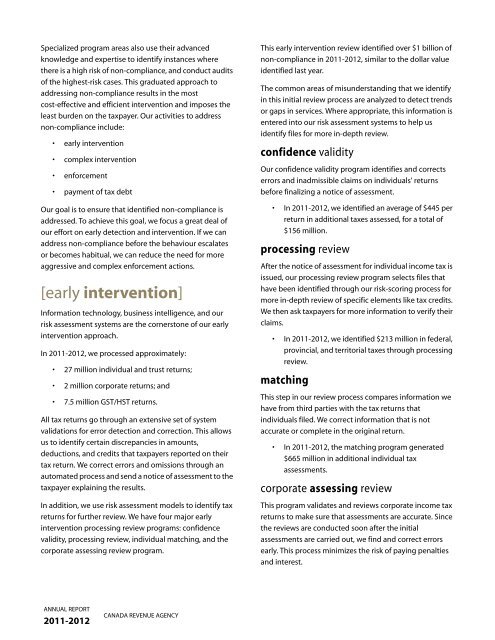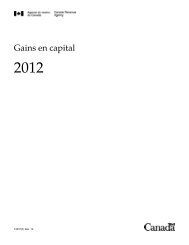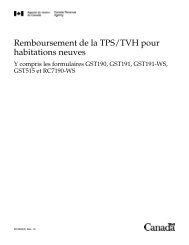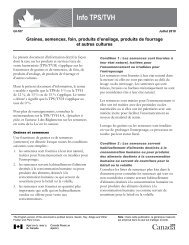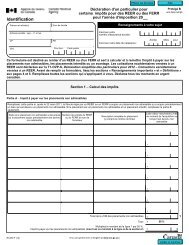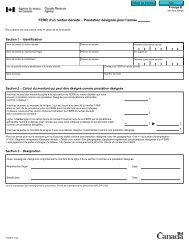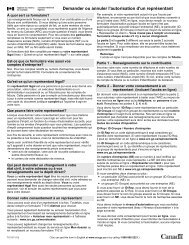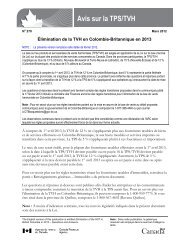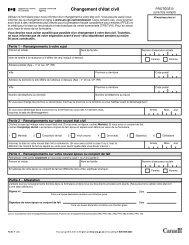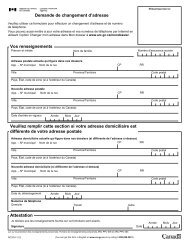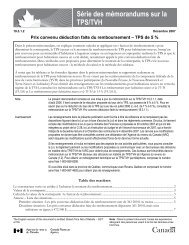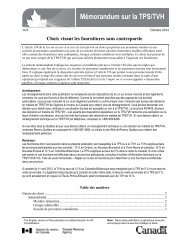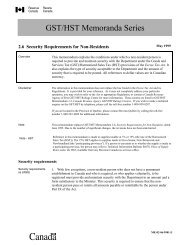CRA Annual Report to Parliament 2011-2012 (PDF - Agence du ...
CRA Annual Report to Parliament 2011-2012 (PDF - Agence du ...
CRA Annual Report to Parliament 2011-2012 (PDF - Agence du ...
You also want an ePaper? Increase the reach of your titles
YUMPU automatically turns print PDFs into web optimized ePapers that Google loves.
Specialized program areas also use their advanced<br />
knowledge and expertise <strong>to</strong> identify instances where<br />
there is a high risk of non-compliance, and con<strong>du</strong>ct audits<br />
of the highest-risk cases. This gra<strong>du</strong>ated approach <strong>to</strong><br />
addressing non-compliance results in the most<br />
cost-effective and efficient intervention and imposes the<br />
least burden on the taxpayer. Our activities <strong>to</strong> address<br />
non-compliance include:<br />
early intervention<br />
complex intervention<br />
enforcement<br />
payment of tax debt<br />
Our goal is <strong>to</strong> ensure that identified non-compliance is<br />
addressed. To achieve this goal, we focus a great deal of<br />
our effort on early detection and intervention. If we can<br />
address non-compliance before the behaviour escalates<br />
or becomes habitual, we can re<strong>du</strong>ce the need for more<br />
aggressive and complex enforcement actions.<br />
[early intervention]<br />
Information technology, business intelligence, and our<br />
risk assessment systems are the corners<strong>to</strong>ne of our early<br />
intervention approach.<br />
In <strong>2011</strong>-<strong>2012</strong>, we processed approximately:<br />
27 million indivi<strong>du</strong>al and trust returns;<br />
2 million corporate returns; and<br />
7.5 million GST/HST returns.<br />
All tax returns go through an extensive set of system<br />
validations for error detection and correction. This allows<br />
us <strong>to</strong> identify certain discrepancies in amounts,<br />
de<strong>du</strong>ctions, and credits that taxpayers reported on their<br />
tax return. We correct errors and omissions through an<br />
au<strong>to</strong>mated process and send a notice of assessment <strong>to</strong> the<br />
taxpayer explaining the results.<br />
In addition, we use risk assessment models <strong>to</strong> identify tax<br />
returns for further review. We have four major early<br />
intervention processing review programs: confidence<br />
validity, processing review, indivi<strong>du</strong>al matching, and the<br />
corporate assessing review program.<br />
ANNUAL REPORT<br />
<strong>2011</strong>-<strong>2012</strong><br />
CANADA REVENUE AGENCY<br />
This early intervention review identified over $1 billion of<br />
non-compliance in <strong>2011</strong>-<strong>2012</strong>, similar <strong>to</strong> the dollar value<br />
identified last year.<br />
The common areas of misunderstanding that we identify<br />
in this initial review process are analyzed <strong>to</strong> detect trends<br />
or gaps in services. Where appropriate, this information is<br />
entered in<strong>to</strong> our risk assessment systems <strong>to</strong> help us<br />
identify files for more in-depth review.<br />
confidence validity<br />
Our confidence validity program identifies and corrects<br />
errors and inadmissible claims on indivi<strong>du</strong>als’ returns<br />
before finalizing a notice of assessment.<br />
In <strong>2011</strong>-<strong>2012</strong>, we identified an average of $445 per<br />
return in additional taxes assessed, for a <strong>to</strong>tal of<br />
$156 million.<br />
processing review<br />
After the notice of assessment for indivi<strong>du</strong>al income tax is<br />
issued, our processing review program selects files that<br />
have been identified through our risk-scoring process for<br />
more in-depth review of specific elements like tax credits.<br />
We then ask taxpayers for more information <strong>to</strong> verify their<br />
claims.<br />
In <strong>2011</strong>-<strong>2012</strong>, we identified $213 million in federal,<br />
provincial, and terri<strong>to</strong>rial taxes through processing<br />
review.<br />
matching<br />
This step in our review process compares information we<br />
have from third parties with the tax returns that<br />
indivi<strong>du</strong>als filed. We correct information that is not<br />
accurate or complete in the original return.<br />
In <strong>2011</strong>-<strong>2012</strong>, the matching program generated<br />
$665 million in additional indivi<strong>du</strong>al tax<br />
assessments.<br />
corporate assessing review<br />
This program validates and reviews corporate income tax<br />
returns <strong>to</strong> make sure that assessments are accurate. Since<br />
the reviews are con<strong>du</strong>cted soon after the initial<br />
assessments are carried out, we find and correct errors<br />
early. This process minimizes the risk of paying penalties<br />
and interest.


